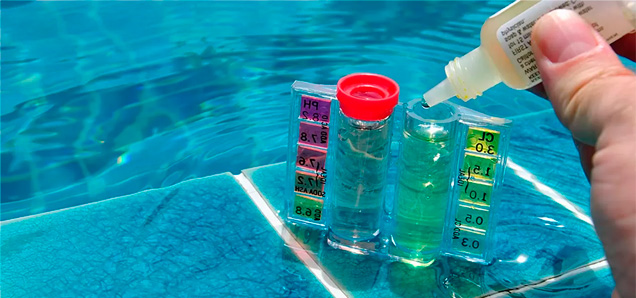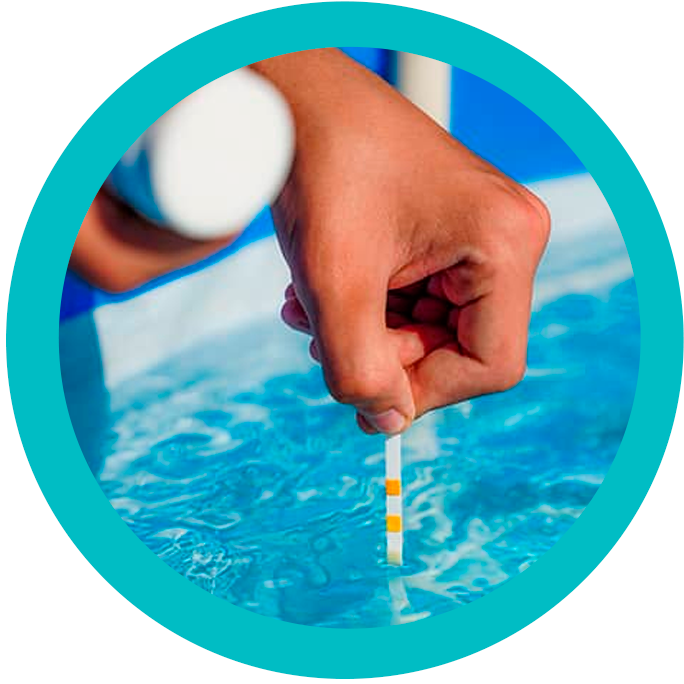SOUTHWEST FLORIDA’S PREMIER Fiberglass Pool & Spa INSTALLER
SOUTHWEST FLORIDA’S PREMIER Fiberglass Pool & Spa INSTALLER
Appearance is not a reliable gauge of the condition of your pool. A good test kit must be used regularly to ensure clear and sanitary water. Your test kit should be able to test sanitizer level, pH and total alkalinity. Your test kit should also include the type and amount of products required to adjust your pool water chemistry. These are the chemical factors that can change quickly and require frequent adjustments.
Note: For best results when testing pool water, take water samples from at least 18″ below surface, opposite side of a return jet. Make sure to hold test reagent bottles vertically when applying reagents to test cells. Chemical reagents should be replaced every year.
There are several other factors that make up proper water balance such as Calcium Hardness, Total Dissolved Solids, Chlorine, Stabilizer & Metals that once adjusted to proper levels only need to be tested monthly.
Bring a pool water sample to your professional pool dealer for a complete water analysis every 4 weeks. For surface warranty purposes, you must keep monthly water balance records in order for supporting the claim.

1. Test and Balance Water:
Test pool water for chlorine residual, pH, Total Alkalinity, Calcium Hardness, Cyanuric Acid (chlorine stabilizer), and metals. Its very important to also test make up water (the water you either fill or top the pool up with) to determine any pollutants you may be adding.
2. Balance the water to the following chemical ranges:
pH Level – 7.2 to 7.6 (Ideal 7.4 to 7.6) Total Alkalinity – 80-120 ppm Calcium Hardness – 200 – 400 ppm Cyanuric Acid (chlorine stabilizer) 30 to 40 ppm Metals – 0 ppm
3. Apply a Metal/Scale Inhibitor type product that has a tolerance for high chlorine levels. Follow manufactures label directions for proper application and use.
4. Establish a chlorine level of 1 to 2 ppm. Shock the pool 2 days later using either chlorine or nonchlorine shock product per label directions to remove organic contaminants and make the water sparkle.
Test 1 to 2 times a week. Always check total alkalinity first. Proper range for total alkalinity for your Fiberglass Pool is between 80 – 120 ppm. The total alkalinity is the measure of alkaline materials dissolved in the water. Proper levels of total alkalinity serve as a buffer to prevent fluctuations in the pH. To increase your total alkalinity, add a Total Alkalinity Increaser. To lower your total alkalinity you may need to add doses of ph lower (dry acid) or Muriatic Acid. Always follow the directions of the chemical container. Total Alkalinity kept in the proper range will help stabilize the pH level.
Test 2 times per week. PH is a measure of the relative acidity and alkalinity of water. The pH scale runs from the highly acid range of 0 to the highly alkaline range of 14. A pH level of 7 is considered neutral. The ideal and most comfortable range for your Fiberglass pool water is a pH between 7.2 to 7.6 (Ideal 7.4 to 7.6).
Problems with “Out of Range” pH: Low pH (pH below 7.2) causes:
High pH (above 7.6) causes:
It is very important to keep your pH level between 7.2 to 7.6 (Ideal 7.4 to 7.6), to avoid the many problems that can occur with your pool’s surface, equipment and water.
What causes the pH to change?
PH can vary week-to-week, even day-to-day. Factors that affect the pH include: Swimmers, rainwater, fresh water, chlorine, and the total alkalinity.
Adjusting pH
If the pH is low, add a pH increaser (Sodium Carbonate) to raise the pH. Follow directions on the container for dosage and application. Re-test after four hours and repeat dosage if necessary. If the pH is high, add pH decreaser (Sodium Bisulfate) or Muriatic Acid to lower the pH. Follow directions on container for dosage and application. Note: If you cannot maintain a proper pH level, check total alkalinity and adjust Accordingly. Proper total alkalinity stabilizes the pH level.
Use the Langlier index to determine proper water balance. Calculators can be found online.
Test 2 times per week Chlorine is the most widely used effective and economical sanitizer for swimming pools. Chlorine controls algae, effectively kills bacteria and other disease causing organisms, and removes waste products through oxidation. You should maintain low, but constant chlorine levels. Proper chlorine levels for your Fiberglass Pool should be between 1.0 to 3.0 ppm (1.5 is ideal)

Why is shocking your pool necessary?
Waste enters the pool through wind, rain, and people. Many of these wastes are not filterable and combine with the chlorine to form “chloramines,” a chlorine nitrogen complex. Chloramines cause eye irritation and reduce the amount of “free” chlorine available to provide sanitation. A buildup of waste (in the form of chloramines) also causes the water to become cloudy or have a dull appearance.
What Shocking Does
Shocking burns out wastes and transforms the chloramines back to free available chlorine. Shocking uses oxidation to restore the pool water to a sparkling, sanitary, comfortable condition. Normal chlorine levels are usually unable to accomplish this.
How and When to Shock
Shocking should be done every one to two weeks. Heavy bather use and warm water temperatures will further increase the need to shock. The addition of 1 pound of chlorine shock per 10,000 gallons of pool water is usually sufficient. Preferably shock the pool in the evening.
NOTE: Additional shock may be needed after a rain storm, heavy bather load, hot weather or additional fresh water filling.
Calcium Hardness
Test monthly.
Calcium naturally occurs in water. Different areas of the country have higher and lower levels of calcium in the water. The higher the calcium concentration in the water, the more prone the pool is to calcium leeching. When the pH is maintained between 7.2 and 7.4 the calcium is balanced in the water. Calcium levels should be maintained between 200 – 400 parts per million. When the pH rises above 7.4, calcium begins to precipitate out of the water and cling to the swimming pool surface. The higher the pH is allowed to go, the more pronounced the calcification can become. Obviously the problem occurs more often in areas with higher natural concentrations of calcium in the water (also known as hard water). All that is required for calcium to fall out of solution creating a layer of scale is a pH of 7.5 or higher and your overall water balance not being in proper parameters.
If a swimming pool is exposed to high pH levels then an inconsistent discoloration below the waterline can occur. This whitening is due to calcium leeching from the pool water and clinging to the walls, steps and floor of the pool. It can be seen as a streak or solid area and is especially noticeable when the water level is lowered and the calcium dries.
If the swimming pool is exposed to high pH levels and a discoloration starts to occur the problem can be possibly treated in the early stage, say 1 to 3 months, with a chemical solution.
If the swimming pool is maintained with very high pH over a period of time, longer than 3 months then the problem can turn severe. The calcium begins to combine with the pool chlorine producing a chemical salt known as calcium chloride. This salt attaches itself to the pool surface and causes the surface to appear significantly lighter especially when dehydrated. In advanced cases the calcium chloride is so bad that the pool even when hydrated (full of water) still shows the whitening.
If the pool has advanced calcium chloride but the gel coat returns to normal when hydrated then the pool can sometimes be treated using a chemical solution outlined above. It will take up to 6 months to allow the treatment to totally dissolve the calcium chloride.
If the gel coat has severe damage by the salt (Calcium Chloride) and it is visible when hydrated then the solution is to remove the salt from the surface of the pool. At this point the calcium has invaded the gel coat itself. This occurs with low levels of PH and calcium. The water becomes very corrosive and will penetrate the surface with calcium chloride. With very careful attention to establishing proper water balance and sanitation levels along with a good stain and scale and regular brushing of the pool walls we have seen some reversal of the staining but it is a slow process and may not entirely remove all the calcium.
Please note that we recommend that you use a metal/scale inhibitor type product on a weekly treatment basis. Failure to do so will void the surface warranty on your pool. Make sure to discuss this with your water care professional for suggestion on the type of product.
Pool Stabilizer (Cyanuric Acid)
Test monthly.
Sunlight is a major factor in the consumption of chlorine. When cyanuric acid is added to the pool water, it makes the chlorine more resistant to the U.V. rays of the sun. Chlorine stabilizer helps keep your chlorine levels more constant while reducing your chlorine costs. The proper chlorine stabilizer level for your Fiberglass Pool should be between 30 to 60 ppm.

Sunny Florida Pools brings you quality fiberglass pools with an unmatched focus on bringing your backyard vision to life.
Copyright ©2024 Sunny Florida Pools , Inc. All Rights Reserved.